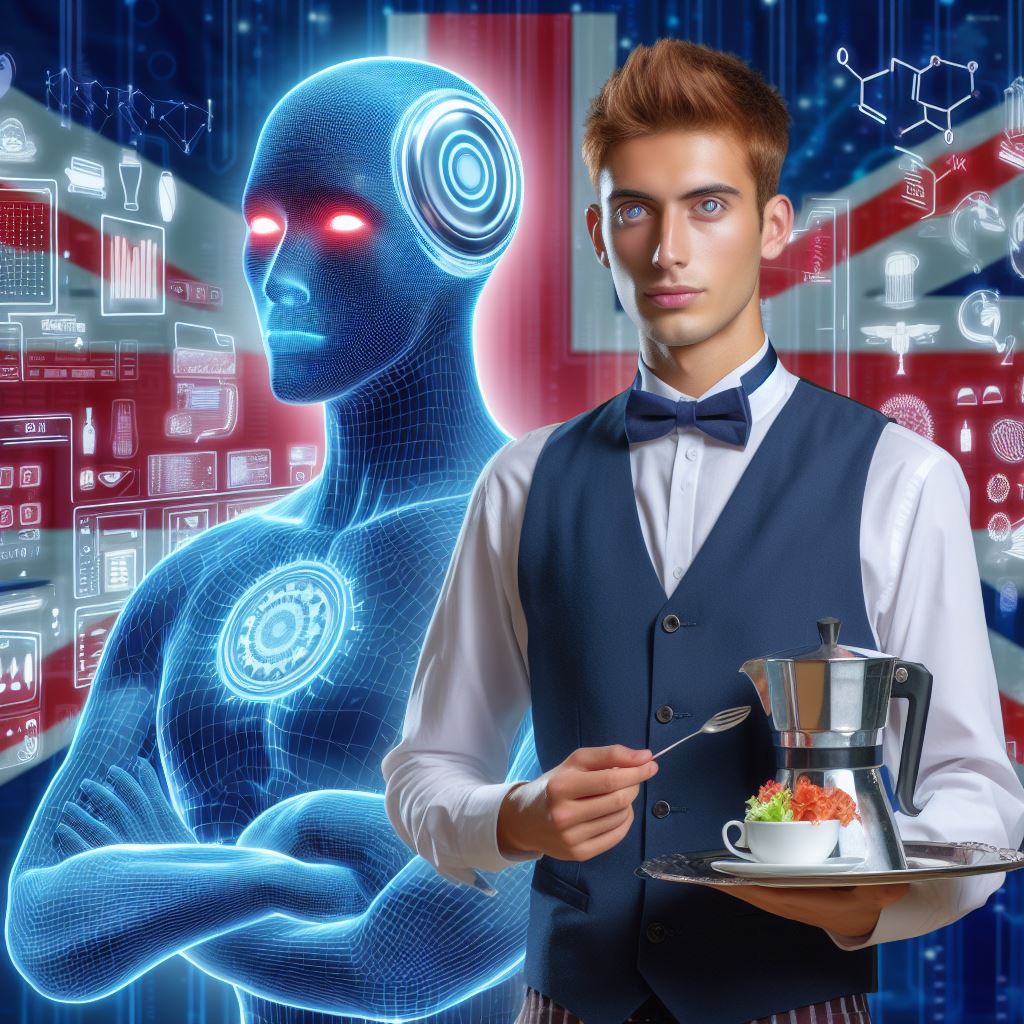Introduction
Technology plays a crucial role in shaping industries across the globe.
From healthcare to finance, innovations have revolutionized various sectors, enhancing productivity and customer experiences.
In the context of the UK’s waitstaff roles, technology has also had a growing impact.
Traditionally, waitstaff in the UK were responsible for taking orders, serving food and drinks, and ensuring customer satisfaction.
However, with advancements in technology, their roles have evolved.
From electronic ordering systems and mobile payment options to tableside tablets for ordering, technology has streamlined processes and improved efficiency.
One of the key benefits of technology in waitstaff roles is the reduction of human error.
With electronic ordering systems, mistakes in taking food and drink orders are minimized, ensuring accuracy and customer satisfaction.
Moreover, mobile payment options provide convenience, allowing customers to settle their bills quickly and easily.
Another significant impact of technology on waitstaff roles is the improvement in customer service.
Tableside tablets provide additional information about menu items, allergens, and dietary preferences, allowing waitstaff to cater to individual needs more effectively.
This enhances the overall dining experience, leaving customers more satisfied and likely to return.
In short, technology has transformed the traditional waitstaff roles in the UK.
From enhancing efficiency to improving customer service, innovations such as electronic ordering systems and tableside tablets have had a positive impact on the industry.
As technology continues to advance, it will be essential for waitstaff to adapt and harness its potential for continued growth and success.
Personalized UK Career Consulting
Receive tailored career guidance designed just for you. Get actionable steps and expert support to boost your career in 1-3 days. Take control of your career now.
Get StartedEvolution of Technology in the Hospitality Industry
Historical background on the use of technology in the industry
In the past, waitstaff roles relied on manual processes and face-to-face interaction with customers.
However, technology has gradually infiltrated the hospitality industry, transforming the way restaurants operate.
From the introduction of electronic cash registers to the implementation of computerized reservation systems, technology has become a crucial component.
Introduction of technological advancements in customer service
1. Online booking systems
Restaurants now offer online platforms where customers can make reservations without the need for phone calls or physical visits.
This advancement has streamlined the booking process, making it convenient for both customers and staff.
2. Self-service kiosks
Self-service kiosks allow customers to browse menus, place orders, and even make payments without the assistance of waitstaff.
These kiosks have been widely adopted, particularly in fast-food chains, to enhance efficiency and reduce waiting times.
3. Mobile ordering applications
With the increasing use of smartphones, many restaurants now offer mobile ordering applications.
Customers can browse menus, place orders, and even pay from the comfort of their own devices.
Such applications improve efficiency, reduce errors, and cater to the growing demand for contactless interactions.
Benefits and challenges associated with implementing technology in the sector
Implementing technology in the hospitality industry brings several benefits, but it also comes with its fair share of challenges.
Benefits include
- Streamlined processes: Technology allows for faster and more efficient operations, reducing the burden on waitstaff.
- Improved customer experience: Online booking systems and mobile applications enhance convenience and satisfaction.
- Increase in revenue: With digital platforms, restaurants can reach a wider audience and generate more business.
Challenges include
- Initial investment: Acquiring and implementing new technologies can be costly for restaurants, especially smaller businesses.
- Training and adaptation: Staff members need to be trained on using new technologies, which can be time-consuming.
- Privacy and security concerns: The use of digital platforms may expose customer data to potential security breaches.
- Reduced personal interaction: The shift towards digital interactions may result in a decline in face-to-face customer service.
In fact, the hospitality industry has embraced technology to enhance customer service and operations.
However, while technological advancements bring undeniable benefits, they also pose challenges that businesses must address.
It is crucial for restaurants and waitstaff to find a balance between adopting new technologies and maintaining the human touch that makes dining experiences truly memorable.
Your Dream Job Starts with a Perfect CV
Get a tailored CV and cover letter that captures your unique strengths and stands out in your industry. Let us help you make an unforgettable first impression.
Get StartedRead: UK Waitstaff: Balancing Speed and Hospitality
Automation in Waitstaff Roles
How technology is automating certain tasks
- Automated order-taking systems: These systems allow customers to place their orders digitally without the need for waitstaff.
- Tabletop tablets for ordering and payment: Restaurants are increasingly adopting tablets on tables to enable customers to order and pay directly.
- Automated inventory management systems: Technology allows for precise tracking of inventory, reducing human error and stock management time.
Pros and cons of automation in waitstaff roles
- Improved efficiency and accuracy: Automation enables faster order processing, reducing wait times and minimizing errors in the order-taking process.
- Potential job displacement and reduced human touch: As automation replaces certain tasks, there is a concern regarding job loss and the decrease in personal interaction with customers.
Examples of UK establishments adopting automation in their workflow
Many UK restaurants and cafes have embraced automation to streamline their operations and enhance customer experiences.
Read: Waitstaff Training: Best Practices in the UK
Upskilling and Adaptation
Importance of upskilling for waitstaff in response to technological advancements
Acquiring digital literacy
Waitstaff must become proficient in using technology to enhance their job performance.
Familiarity with new software and tools
Being knowledgeable about the latest software and tools increases efficiency and productivity.
Opportunities for waitstaff to learn and improve their skills
Training programs offered by employers
Employers should provide training programs to help waitstaff adapt to technological changes.
Online resources and courses for waitstaff
Waitstaff can take advantage of online resources and courses to enhance their skills.
Benefits and challenges of upskilling for waitstaff
Upskilling has several benefits for waitstaff, but it also comes with its own set of challenges.
Read: The Pay Scale: What UK Waitstaff Really Earn
Enhanced Guest Experience through Technology
How technology improves the overall guest experience
- Personalized digital menus enhance the guest experience by accommodating specific dietary needs and preferences.
- Efficient communication between staff and guests is facilitated through smartphone apps, ensuring orders are accurate and timely.
- Feedback systems allow restaurants to monitor and quickly address customer satisfaction issues, further enhancing the guest experience.
Examples of UK restaurants successfully utilizing technology for a better guest experience
In today’s rapidly evolving technological landscape, UK restaurants are leveraging innovative solutions to improve their guest experience.
The incorporation of technology not only streamlines operations but also enhances customer satisfaction, resulting in repeat business and positive word-of-mouth.
Here are some examples of how technology is revolutionizing the guest experience in the UK hospitality industry:
Personalized digital menus
Gone are the days of paper menus with limited options.
UK restaurants are now adopting digital menus, allowing guests to personalize their orders according to dietary needs and preferences.
Guests can easily identify allergens and make adjustments to their dishes, ensuring a seamless dining experience without compromising on taste or health requirements.
This technology empowers guests with more control over their dining choices, resulting in higher satisfaction levels.
Efficient communication between staff and guests through apps
Smartphone apps have become a game-changer for UK restaurants, enabling efficient communication between staff and guests.
These apps allow guests to place orders, request assistance, and provide feedback directly to the restaurant’s staff.
By eliminating the need for flagging down servers or waiting in queues, technology improves the overall efficiency and speed of service, leading to a more positive guest experience.
Feedback systems to monitor and address customer satisfaction
Many UK restaurants have implemented feedback systems through technology to monitor and address customer satisfaction.
These systems allow guests to provide real-time feedback on their dining experience, enabling management to quickly identify and resolve any issues.
By promptly addressing customer concerns, restaurants can improve the overall guest experience and build long-term customer loyalty.
In essence, technology plays a vital role in enhancing the guest experience in UK restaurants.
Personalized digital menus, efficient communication apps, and feedback systems are just a few examples of how technology has transformed the hospitality industry.
By embracing these technological advancements, UK restaurants can deliver personalized, efficient, and satisfactory experiences to their guests, ensuring continued success in the ever-evolving digital landscape.
Read: UK Etiquette: A Waitstaff’s Perspective
Optimize Your LinkedIn for Success
Boost your LinkedIn profile with a professional bio, keyword-rich headline, and strategic recommendations that attract recruiters. Stand out from the crowd and get noticed.
Optimize Now
Potential Future Developments
Speculation on further advancements in technology impacting waitstaff roles
In the fast-paced world of technology, it is exciting to speculate on what further advancements may be in store for waitstaff roles in the UK.
As technology continues to evolve, it is likely that the role of waitstaff will witness significant changes.
Augmented reality and virtual reality applications
One potential future development is the integration of augmented reality (AR) and virtual reality (VR) applications in the daily tasks of waitstaff.
AR and VR have already made their way into various industries, and the foodservice sector may not be an exception.
Imagine a scenario where waitstaff wear AR glasses or headsets that provide them with real-time information about the menu items, ingredients, allergens, and preparation methods.
This technology could enhance their ability to answer customer inquiries accurately and efficiently.
Moreover, virtual reality could revolutionize the dining experience for customers.
By wearing VR headsets, customers might be transported to different virtual environments while enjoying their meals.
This immersive experience could be particularly appealing in themed restaurants or for special occasions.
Potential integration of artificial intelligence in waitstaff roles
Another potential future development is the integration of artificial intelligence (AI) in waitstaff roles.
AI-powered systems have already made their way into various customer service functions, and the restaurant industry could benefit from this technology too.
AI chatbots or voice assistants could assist waitstaff in taking orders, providing recommendations, and handling customer queries.
These intelligent systems could improve the efficiency of order taking and reduce errors in communication between customers and waitstaff.
AI could also be used to analyze customer preferences and personalize dining experiences.
By leveraging past interactions and data, AI systems could suggest personalized menu items or make recommendations based on individual preferences, dietary restrictions, or past dining history.
In review, as technology continues to advance, the potential future developments in waitstaff roles are exciting to consider.
Augmented reality and virtual reality applications could enhance both the operational efficiency of waitstaff and the dining experiences for customers.
Furthermore, the integration of artificial intelligence could revolutionize various aspects of waitstaff roles, from order taking to personalization.
However, it is essential to find the right balance between technology and human touch in the hospitality industry, as the personal interactions and rapport between waitstaff and customers play a crucial role in creating a positive dining experience.
Conclusion
Recap of the impact of technology on UK waitstaff roles
Technology has drastically changed the roles of waitstaff in the UK.
From digital menus to automated ordering systems, these advancements have streamlined processes and improved efficiency.
Additionally, online reservation platforms and review sites have influenced customer behavior and increased competition among restaurants.
However, technology has also brought challenges, such as the need for staff to adapt to new tools and the potential displacement of jobs.
Final thoughts on the implications for the future of the industry
The impact of technology on waitstaff roles in the UK highlights the need for continuous learning and flexibility.
As technology continues to evolve, waitstaff should be prepared to embrace and adapt to these changes.
Restaurants that successfully integrate technology into their operations will have a competitive edge and be better equipped to meet customer demands in the digital age.
Encouragement for waitstaff to embrace and adapt to technological changes
While technology may transform some aspects of waitstaff roles, it is not meant to replace human interaction and hospitality.
Waitstaff should view technology as a tool to enhance their service, improve efficiency, and provide a better overall dining experience.
Embracing technological changes and acquiring new skills will ensure waitstaff remain valuable and indispensable in the industry’s future.
[E-Book for Sale]
500 Cutting-Edge Tech Startup Ideas for 2024 & 2025: Innovate, Create, Dominate
$19.99 • 500 Tech Startup Ideas • 62 pages
You will get inspired with 500 innovative tech startup ideas for 2024 and 2025, complete with concise descriptions to help you kickstart your entrepreneurial journey in AI, Blockchain, IoT, Fintech, and AR/VR.




